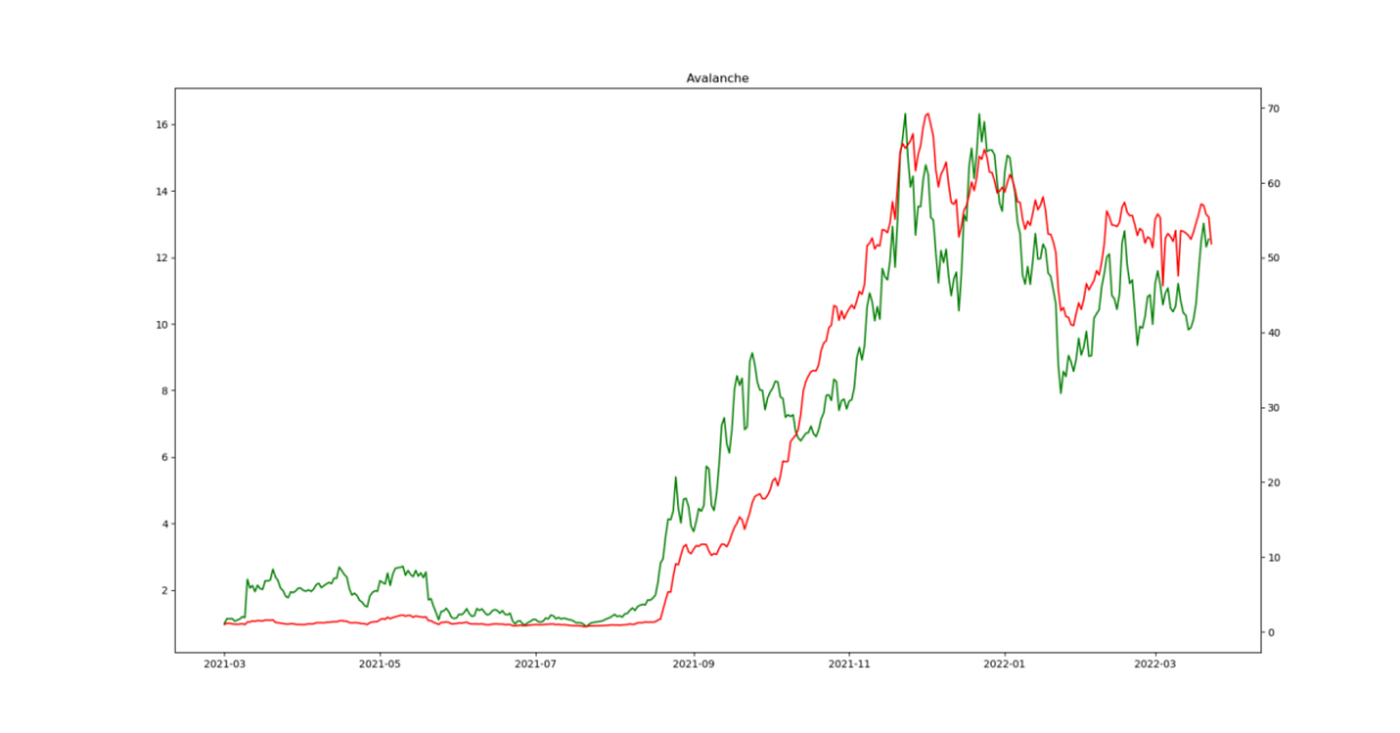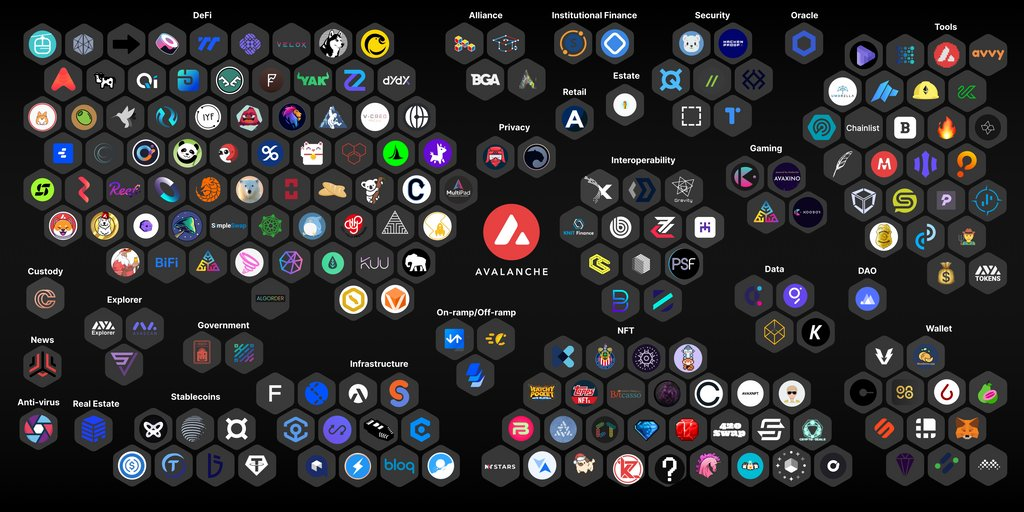The Avalanche ecosystem has flourished since August 2021. At the moment, the TVL of Avalanche has exceeded $10 billion, making it the fourth largest public chain after Ethereum, BSC, and Solana.

Since August 2021, Avalanche has made many key moves to expand its user base:
Assets: The partnership between Avalanche and the US payment service provider Wyre allows users in over 50 countries/regions (including the US) to convert fiat currencies into DeFi assets in the Avalanche ecosystem;
Avalanche has reached cooperation with the crypto e-commerce platform Shopping.io to enable users to shop on Amazon, Walmart, and eBay through AVAX;
Working with Tether, the network launched Avalanche-native USDT, which was soon recognized by mainstream centralized exchanges. Today, most CEX users can quickly deposit and withdraw the token;
Institutional investors that include Polychain and Three Arrows Capital joined a $230 million investment fund for Avalanche-based projects;
In addition, AVAX will also be listed on Coinbase in September 2021, which is another endorsement for investors.

The above picture shows no significant deviation between the market cap and TVL, which indicates that the AVAX price is within a reasonable range, and the project is neither overestimated nor underestimated.
In the following paragraphs, we will analyze the Avalanche ecosystem in terms of several aspects, covering the team, technology, resources, and association with crypto exchanges.
1) Team
Generally speaking, Ava Lab, backed by Emin Gun Sirer, comes with an excellent team background.
Emin Gun Sirer: As Professor of Information Engineering at Cornell University, and co-founder of IC3, Emin Gun Sirer focuses on cryptography research and published the Karma System in 2003, which is the world’s first distributed crypto system that mints coins through PoW (Proof of Work). This 2003 paper remains the most cited paper in this field;
Kevin Sekniqi: An Information Engineering researcher;
Ted Yin: First author of the HotStuff Protocol used in Facebook’s Libra;
BD VP Lydia C and some employees previously worked at Sureview Capital/Sego (family investment office that once received strategic investment from Blackstone Group);
Ava Lab’s consultants include Maureen O’Hara, a Cornell professor, and Adam Kravetz, an executive at Merrill Lynch.
2) Technology
What is unique about Avalanche is that the protocol itself contains three chains (X chain, C Chain, and P Chain). Moreover, it is also EVM-compatible, making it easily accessible to Ethereum projects. For example, AAVE is already compatible with the Avalanche ecosystem, and over 29% of its TVL comes from Avalanche.
P Chain (Platform): The Platform Chain (metadata chain on Avalanche) works to coordinate network validators and facilitate the creation of new subnets.
X Chain (Exchange): The Exchange Chain is mainly related to asset swapping. It creates assets and allows them to be transferred across subnets. The chain can be regarded as the main chain of Avalanche. Users may directly deposit assets into X Chain through exchanges that support Avalanche, and the X Chain address uses the format of “X-avax”;
C Chain (Contract): The Contract Chain, the smart contract chain on Avalanche, is EVM compatible, and developers can create all sorts of smart contract applications on the chain. By adding the Avalanche C-Chain to Metamask, users can transfer assets through the cross-chain bridge between X-Chain and C-Chain and perform DeFi operations. Since the chain is compatible with EVM, its address starts with “0 x”.
3) Resources
Technical consultants: Avalanche is powered by many well-known cryptography professors and scholars.
Big-name institutional investors: Back in 2019, Avalanche received a $6 million investment from institutional/individual investors that include Andreessen Horowitz (a16z), Polychain, Balaji Srinivasan (former CTO of Coinbase), Metastable, Initialized, and Ramtin Naimi (founder of Abstract Ventures). In May 2020, the project completed a $12 million private-round fundraising, led by five institutional investors that include the US digital investment bank giant Galaxy Digital, Bitmain, Initialized Capital, NGC Ventures, and Dragonfly Capital;
Incredible subsidies: In the first half of 2022, Avalanche has hosted the Avalanche Hackathon (Asia), which offers Avalanche funding & support to the top 10 projects. ViaBTC Capital has also sponsored the hackathon.

During the hackathon, many outstanding projects (e.g. PEPO Paradise) stood out from all the entries, which cover categories that include DeFi, the metaverse, NFT, GameFi, infrastructure & tools, and Web 3.
PEPO Paradise is a mini-game where players raise pets in a sandbox. The most prominent feature of the game is NFT-based pets — players can raise NFTs in their wallets as pets in PEPO Paradise. Finifugu Games, the studio behind the game, boasts rich experience in game development and has developed two quality mini-games: Otter Ocean (50,000+ downloads) and Too Many Cooks (100,000+ downloads) are both casual games with adorable themes.
The team is semi-anonymous, with members from Hong Kong, London, Italy, Thailand, and Taiwan. The games it launched have won several big awards. Backed by entertaining gameplay, PEPO Paradise features three built-in tokens: PPP (governance token), PPF (food token), and PPC (reward token).
Zecrey is another participant that stood out during the hackathon. The bottom layer of this general privacy protocol based on the account model is powered by ZK-Rollup, which enables stronger privacy protection for asset transactions. On Zecrey, all funds are held by smart contracts on the main chain, while calculations and storage are performed off-chain, keeping users’ assets safe and secure through zero-knowledge proofs. While providing transaction privacy, the protocol significantly lowers fees and improves transaction performance. At the moment, the project has already launched a test version, which has recorded strong statistics — the number of people participating in the test exceeded 70,000, with 500,000+ transfer records.
4. Association with crypto exchanges: Though Avalanche is not yet bound to any exchange, it has built an extensive partnership with Matcha, Kucoin, CoinEx, etc. Moreover, Matcha has founded an Avalanche ecosystem fund to invest in infant Avalanche projects.
5. Avalanche projects: Avalanche has built a well-rounded ecosystem that covers DeFi, wallets, tools, GameFi, NFT, privacy tools, etc. Well-known Avalanche projects include Pangolin (the №1 DEX on Avalanche launched by the protocol) and Zero Exchange (DEX). Meanwhile, the protocol also features some famous projects migrated from other public chains, such as SushiSwap, Ren, bZx Protocol, Reef Finance, etc. When these projects were launched on Avalanche, their token price surged, which brought massive funds to the protocol and gradually drove up its TVL.

DeFi: Avalanche features a large number of DeFi projects (70+). We all know that lending and DEX are the two cornerstones for the development of DeFi. According to data from defillama.com, the TVL of Trader Joe (Avalanche’s largest DEX + lending project) has reached $1.4 billion, while that of BENQI (a lending protocol on Avalanche) ranks second, hitting $1.26 billion.
Tools: Avalanche is powered by a wide array of tools (30+). In particular, Avalaunch is the largest launchpad on Avalanche with official endorsement from the protocol. Most projects launched through Avalaunch have recorded strong performance. Aleph.lm is another practical tool based on Avalanche, and also a second-layer protocol for cross-chain swapping. Right now, Aleph.lm supports public chains that include Ethereum, Avalanche, BSC, Polkadot, Solana, Polygon, and Cosmos. In addition, it has introduced functions covering DApps and SDKs and plans to add more features, such as DID, storage nodes, and virtual machines.
GameFi: GameFi remains a hot blockchain segment at the moment. Compared with public chains like Ethereum and BSC, Avalanche has fewer well-recognized GameFi projects. But still, there are some famous ones. For example, Crabada, a popular and profitable blockchain game on Avalanche, has attracted many players with its unique Loot mode.
Conclusion
Many quality projects have flocked to the recent Avalanche hackathon. As more competent developers join the protocol, the Avalanche ecosystem will further flourish. At the same time, the constant updates and improvements of the protocol will expand its growth prospect in the future.
*The above content cannot be relied on as any investment advice.
 .
.  .
.  .
.  .
.  .
.  .
.  .
.  Shop
Shop




 Latest news:
Latest news: 